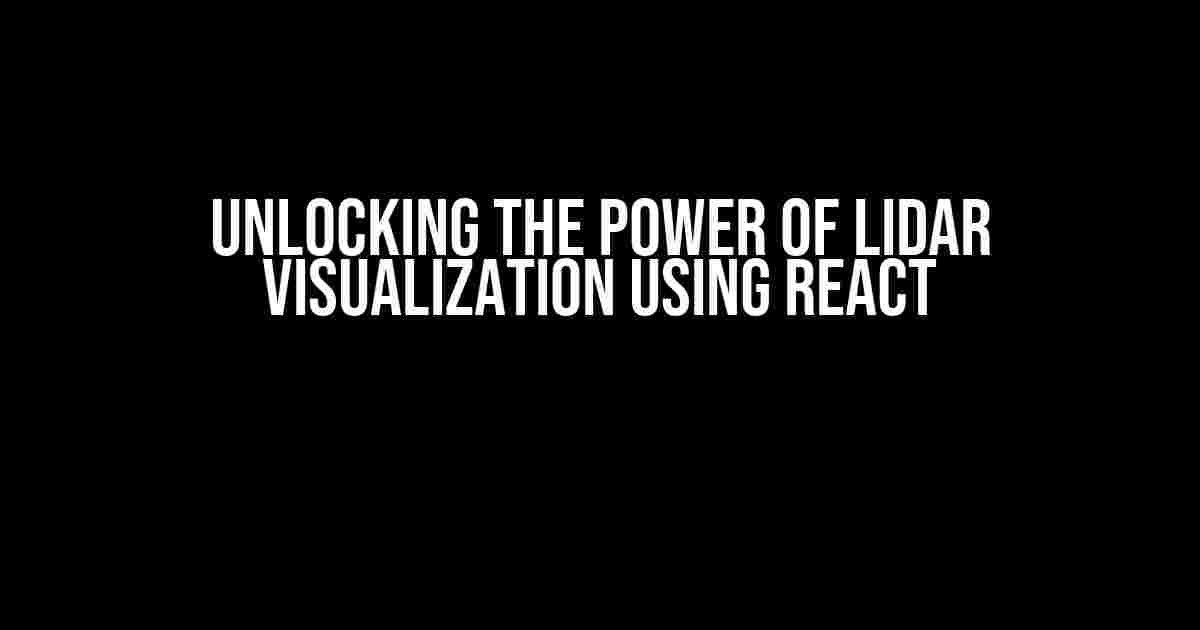Light Detection and Ranging (LiDAR) technology has revolutionized the field of geospatial data analysis, providing highly accurate 3D point cloud data. However, working with LiDAR data can be complex and challenging, especially when it comes to visualization. This is where React, a popular JavaScript library, comes into play. In this article, we will explore the concept of LiDAR visualization using React and how it can enhance your data analysis capabilities.
What is LiDAR Visualization?
LiDAR visualization refers to the process of representing LiDAR point cloud data in a graphical format, allowing users to interact with and analyze the data in a more intuitive and meaningful way. This can include 2D and 3D visualizations, as well as animations and simulations. Effective LiDAR visualization enables researchers, scientists, and engineers to gain insights into complex geospatial data, making it an essential tool in various fields, including surveying, urban planning, environmental monitoring, and more.
The Role of React in LiDAR Visualization
React is a powerful JavaScript library for building user interfaces. When it comes to LiDAR visualization, React offers several advantages, including:
- Efficient data rendering: React’s virtual DOM (Virtual Document Object Model) ensures efficient data rendering, even with large datasets.
- Interactive visualization: React’s event-driven architecture enables the creation of interactive visualizations, allowing users to explore LiDAR data in real-time.
- Customizable components: React’s component-based architecture makes it easy to create custom visualization components, enabling developers to tailor their visualizations to specific needs.
- Seamless integration: React can be easily integrated with popular LiDAR libraries and frameworks, such as Potree, Plasio, and Open3D.
Benefits of Using React for LiDAR Visualization
By leveraging React for LiDAR visualization, developers and researchers can:
- Improve data analysis and interpretation: Interactive visualizations enable users to gain deeper insights into LiDAR data, leading to more accurate analysis and interpretation.
- Enhance collaboration: Web-based React applications can be easily shared and accessed by teams and stakeholders, facilitating collaboration and decision-making.
- Reduce costs: React’s open-source nature and ease of use reduce development costs and complexity, making LiDAR visualization more accessible to a wider audience.
- Increase productivity: React’s efficient data rendering and interactive visualization capabilities enable researchers and scientists to work more efficiently, focusing on analysis and insights rather than data processing.
Best Practices for LiDAR Visualization using React
To get the most out of LiDAR visualization using React, follow these best practices:
- Optimize data preparation: Ensure that LiDAR data is properly cleaned, filtered, and optimized for visualization.
- Choose the right library: Select a suitable LiDAR library or framework that integrates well with React, such as Potree or Plasio.
- Design for interaction: Create interactive visualizations that enable users to explore LiDAR data in real-time.
- Customize visualization components: Develop custom visualization components that cater to specific needs and requirements.
- Test and iterate: Continuously test and refine your LiDAR visualization application to ensure optimal performance and usability.
Conclusion
LiDAR visualization using React offers a powerful combination for unlocking the potential of geospatial data. By leveraging React’s strengths in efficient data rendering, interactive visualization, and customizable components, developers and researchers can create robust, web-based LiDAR visualization applications that enhance data analysis, collaboration, and productivity. Whether you’re working in surveying, urban planning, environmental monitoring, or any other field, React-based LiDAR visualization can help you unlock new insights and drive informed decision-making.
Here are 5 questions and answers about “LiDAR Visualization using React” in a creative voice and tone:
Frequently Asked Questions
Get ready to unleash the power of LiDAR visualization with React! Here are some frequently asked questions to get you started.
What is LiDAR and how does it work?
LiDAR (Light Detection and Ranging) is a remote sensing technology that uses laser light to create high-resolution 3D models of objects and environments. It works by emitting laser pulses and measuring the time it takes for them to bounce back, creating a point cloud of precise spatial data. With React, we can bring this data to life in stunning 3D visualizations!
Why use React for LiDAR visualization?
React is the perfect choice for LiDAR visualization because of its exceptional performance, flexibility, and scalability. With React, we can create fast, interactive, and dynamic 3D visualizations that bring complex LiDAR data to life. Plus, its massive ecosystem of libraries and tools makes it easy to integrate with other technologies and services!
What are some common use cases for LiDAR visualization with React?
LiDAR visualization with React has endless possibilities! Some common use cases include architectural visualization, urban planning, surveying, environmental monitoring, and more. With React, we can create immersive experiences that help professionals and stakeholders explore and interact with LiDAR data in new and innovative ways!
How do I get started with LiDAR visualization using React?
Getting started is easy! First, familiarize yourself with React and its ecosystem. Then, explore popular libraries like Three.js, Pannellum, or A-Frame, which provide powerful tools for 3D visualization. Finally, dive into LiDAR-specific libraries and plugins, such as lidar-react or react-lidar- visualization, to unlock the full potential of LiDAR data in your React applications!
What are some best practices for optimizing LiDAR visualization performance in React?
For optimal performance, make sure to optimize your LiDAR data by reducing point cloud density, using level of detail (LOD) techniques, and applying efficient rendering algorithms. Additionally, leverage React’s virtual DOM, use memoization and caching, and implement efficient state management to ensure smooth and seamless interactions with your LiDAR visualizations!

